
The Army of Northern Virginia was the primary military force of the Confederate States of America in the Eastern Theater of the American Civil War. It was also the primary command structure of the Department of Northern Virginia. It was most often arrayed against the Union Army of the Potomac.
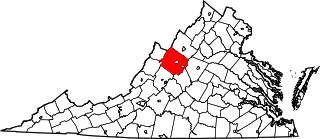
The Battle of Piedmont was fought June 5, 1864, in the village of Piedmont, Augusta County, Virginia. Union Maj. Gen. David Hunter engaged Confederates under Brig. Gen. William E. "Grumble" Jones north of Piedmont. After severe fighting, Jones was killed and the Confederates were routed. Hunter occupied Staunton on June 6 and soon began to advance on Lynchburg, destroying military stores and public property in his wake.
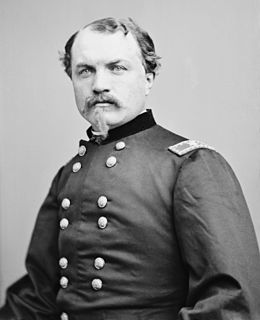
William Woods Averell was a career United States Army officer and a cavalry general in the American Civil War. He was the only Union general to achieve a major victory against the Confederates in the Valley Campaigns of 1864 prior to the arrival of Philip Sheridan, at the Battle of Rutherford's (Carter's) Farm and at the Battle of Moorefield.
The Army of the Shenandoah was a Union army during the American Civil War. First organized as the Department of the Shenandoah in 1861 and then disbanded in early 1862, it became most effective after its recreation on August 1, 1864, under Philip Sheridan. Its Valley Campaigns of 1864 rendered the Shenandoah Valley of Virginia unable to produce foodstuffs for the Confederate States Army, a condition which would speed the end of the Civil War.

The Battle of Cloyd's Mountain was a Union victory in western Virginia on May 9, 1864, that allowed the Union forces to destroy a large bridge on the Virginia and Tennessee Railroad. The railroad was used to carry Confederate troops and supplies, and served important lead and salt mines. It also helped connect the Confederate capital of Richmond with Tennessee, and had telegraph wires along its line for communications. The fight had a high percentage of casualties for both sides, and the Confederate commander, Brigadier General Albert G. Jenkins, was mortally wounded.
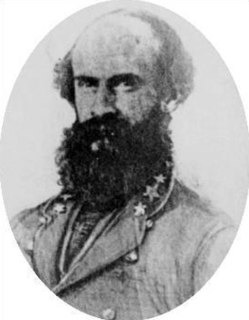
William Edmondson "Grumble" Jones was a Confederate cavalry general with a reputation for being a martinet to his troopers and fractious toward superiors, but acknowledged to be a good commander. After disagreements of a personal nature with J.E.B. Stuart, Jones's brigade was set to guarding supply lines and unavailable during a crucial juncture of the Gettysburg Campaign when Lee suffered from a lack of capable reconnaissance cavalry. As the personality clash between Jones and Stuart escalated, Jones faced charges for impertinence, and was transferred to separate him from Stuart. Jones was killed leading a counter-attack in the 1864 Battle of Piedmont.
The Valley campaigns of 1864 began as operations initiated by Union Lieutenant General Ulysses S. Grant and resulting battles that took place in the Shenandoah Valley of Virginia during the American Civil War from May to October 1864. Some military historians divide this period into three separate campaigns. This article considers them together, as these campaigns interacted and built upon each other.
The Battle of Lynchburg was fought on June 17–18, 1864, two miles outside Lynchburg, Virginia, as part of the American Civil War. The Union Army of West Virginia, under Maj. Gen. David Hunter, attempted to capture the city but was repulsed by Confederate Lt. Gen. Jubal Anderson Early.

The Battle of Cove Mountain occurred in Wythe County, Virginia, on May 10, 1864, during the American Civil War. A Union cavalry division commanded by Brigadier General William W. Averell was prevented from attacking a lead mine located near Wytheville. Confederate forces commanded by Brigadier General John Hunt Morgan, with a detachment of a brigade of cavalry from the command of Brigadier General William E. "Grumble" Jones, stopped Averell at Cove Gap, adjacent to Crockett's Cove and Cove Mountain.
The Battle of Tom's Brook was fought on October 9, 1864, in Shenandoah County, Virginia, during Philip Sheridan's Shenandoah Valley Campaign of the American Civil War. It resulted in a significant Union victory, one that was mockingly dubbed The Woodstock Races for the speed of the Confederate withdrawal.

The 35th Virginia Cavalry Battalion, also known as White's Battalion, White's Rebels and the Comanches, was a Confederate cavalry unit during the American Civil War raised by Elijah V. White in Loudoun County, Virginia in the winter of 1861-62. The battalion was initially raised as border guards along the Potomac River below Harpers Ferry but were ultimately mustered into regular service as part of the Laurel Brigade. Despite this, they continued to play a conspicuous role in the ongoing partisan warfare in Loudoun throughout the war. The battalion was particularly notable during the 1863 Gettysburg Campaign, when it played a prominent role in the Battle of Brandy Station and subsequently conducted a series of raids on Union-held railroads and defensive positions in Maryland and Pennsylvania. The 35th was the first Confederate unit to enter Gettysburg, Pennsylvania.

The Battle of Marion was a military engagement fought between units of the Union Army and the Confederate Army during the American Civil War near the town of Marion, Virginia. The battle was part of Union Maj. Gen. George Stoneman's attack upon southwest Virginia, aimed at destroying Confederate industrial infrastructure near Saltville and Marion. Union Cavalry and Infantry regiments—some 4,500 soldiers in total—left Tennessee on December 17 for southwestern Virginia.
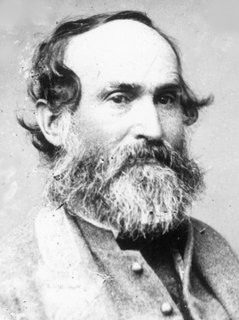
Jubal Anderson Early was a Virginia lawyer and politician who became a Confederate general during the American Civil War. Trained at the United States Military Academy, Early resigned his U.S. Army commission after the Second Seminole War and his Virginia military commission after the Mexican–American War, in both cases to practice law and participate in politics. Accepting a Virginia and later Confederate military commission as the American Civil War began, Early fought in the Eastern Theater throughout the conflict. He commanded a division under Generals Stonewall Jackson and Richard Ewell, and later commanded a corps. A key Confederate defender of the Shenandoah Valley, during the Valley Campaigns of 1864, Early made daring raids to the outskirts of Washington, D.C., and as far as York, Pennsylvania, but was crushed by Union forces under General Philip Sheridan, losing over half his forces and leading to the destruction of much of the South's food supply. After the war, Early fled to Mexico, then Cuba and Canada, and upon returning to the United States took pride as an "unrepentant rebel." Particularly after the death of Gen. Robert E. Lee in 1870, Early delivered speeches establishing the Lost Cause position. Early helped found the Southern Historical Society and memorial associations.

1st Maryland Cavalry Battalion, Potomac Home Brigade, originally organized as the 1st Potomac Home Brigade Cavalry, "Cole's Cavalry" was formed under the guidance of Henry A. Cole. There are also references to it being designated as Cole's 1st Volunteer Maryland Cavalry. The unit, a battalion, originally consisted of four companies, A, B, C & D and was initially enlisted between August 10 and November 27, 1861.
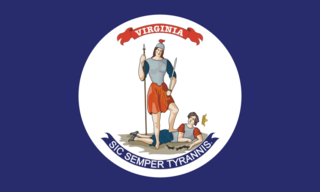
The 45th Virginia Infantry Regiment was an infantry regiment raised in the Commonwealth of Virginia for service in the Confederate States Army during the American Civil War. It fought mostly in the mountainous area that today encompasses the border regions of Virginia and West Virginia, and was part of Jubal Early's Army of the Valley during the Valley Campaigns of 1864.

The 64th Virginia Mounted Infantry Regiment was formed from troops raised in Lee, Scott, Wise and Buchanan counties in Virginia for service in the Confederate States Army during the American Civil War. It served as an infantry regiment, a cavalry regiment, and a mounted infantry (dragoon) unit, and had a mixed reputation.

The 3rd Virginia Cavalry Regiment was a cavalry regiment raised in Tidewater and Southside Virginia for service in the Confederate States Army during the American Civil War. Initially assigned to defend the Hampton Roads area, it fought mostly with the Army of Northern Virginia. As shown by the company table below, members were raised in eight counties: Mecklenburg, Elizabeth City, New Kent, Halifax, Nottoway, Cumberland, Dinwiddie, and Prince Edward Counties.
The following list is a bibliography of American Civil War Confederate military unit histories and are generally available through inter-library loan. More details on each book are available at WorldCat. For an overall national view, see Bibliography of the American Civil War. For histories of the Union, see Bibliography of American Civil War Union military unit histories. For a guide to web sources see: Carter, Alice E.; Jensen, Richard. The Civil War on the Web: A Guide to the Very Best Sites—Completely Revised and Updated (2003).

The 20th Pennsylvania Cavalry was a cavalry regiment of the Union Army which fought during the American Civil War. Also known as the 181st Pennsylvania Volunteers, it was initially led by Colonel John E. Wynkoop, Lieutenant Colonel William Rotch Wister, and Major Samuel W. Comly.

Lowry's Artillery, also known as the Centerville Rifles, was a unit of the Confederate States Army, and was organized by Dr. William M. Lowry in Monroe County, Virginia, with approximately 100 men. They were officially mustered into Confederate service on June 8, 1861. Dr. Lowry was elected captain, with George Beirne Chapman as 1st Lt., William V. Young as 2nd Lt., Charles Dunlap as 3rd Lt., John H. Pence as orderly sergeant, A.J. Keadle, 1st. Sgt., J.P. Shanklin, 2nd Sgt., and J.C. Woodson, 3rd Sgt. By the end of the war the unit had enrolled 219 men.











